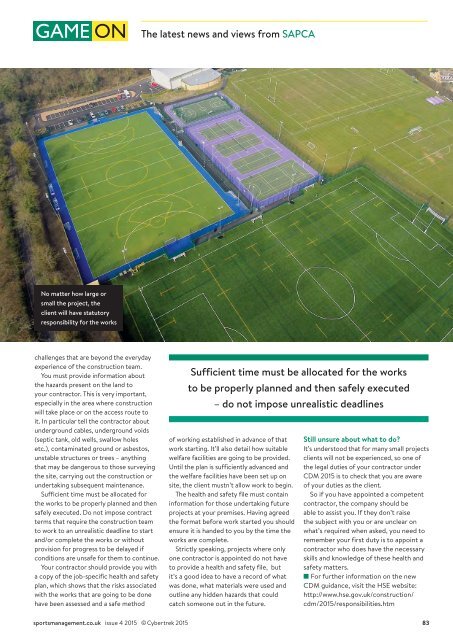EDDIE IZZARD
SM_issue4_2015
SM_issue4_2015
You also want an ePaper? Increase the reach of your titles
YUMPU automatically turns print PDFs into web optimized ePapers that Google loves.
The latest news and views from SAPCA<br />
No matter how large or<br />
small the project, the<br />
client will have statutory<br />
responsibility for the works<br />
challenges that are beyond the everyday<br />
experience of the construction team.<br />
You must provide information about<br />
the hazards present on the land to<br />
your contractor. This is very important,<br />
especially in the area where construction<br />
will take place or on the access route to<br />
it. In particular tell the contractor about<br />
underground cables, underground voids<br />
(septic tank, old wells, swallow holes<br />
etc.), contaminated ground or asbestos,<br />
unstable structures or trees – anything<br />
that may be dangerous to those surveying<br />
the site, carrying out the construction or<br />
undertaking subsequent maintenance.<br />
Sufficient time must be allocated for<br />
the works to be properly planned and then<br />
safely executed. Do not impose contract<br />
terms that require the construction team<br />
to work to an unrealistic deadline to start<br />
and/or complete the works or without<br />
provision for progress to be delayed if<br />
conditions are unsafe for them to continue.<br />
Your contractor should provide you with<br />
a copy of the job-specific health and safety<br />
plan, which shows that the risks associated<br />
with the works that are going to be done<br />
have been assessed and a safe method<br />
Sufficient time must be allocated for the works<br />
to be properly planned and then safely executed<br />
– do not impose unrealistic deadlines<br />
of working established in advance of that<br />
work starting. It’ll also detail how suitable<br />
welfare facilities are going to be provided.<br />
Until the plan is sufficiently advanced and<br />
the welfare facilities have been set up on<br />
site, the client mustn’t allow work to begin.<br />
The health and safety file must contain<br />
information for those undertaking future<br />
projects at your premises. Having agreed<br />
the format before work started you should<br />
ensure it is handed to you by the time the<br />
works are complete.<br />
Strictly speaking, projects where only<br />
one contractor is appointed do not have<br />
to provide a health and safety file, but<br />
it’s a good idea to have a record of what<br />
was done, what materials were used and<br />
outline any hidden hazards that could<br />
catch someone out in the future.<br />
Still unsure about what to do?<br />
It’s understood that for many small projects<br />
clients will not be experienced, so one of<br />
the legal duties of your contractor under<br />
CDM 2015 is to check that you are aware<br />
of your duties as the client.<br />
So if you have appointed a competent<br />
contractor, the company should be<br />
able to assist you. If they don’t raise<br />
the subject with you or are unclear on<br />
what’s required when asked, you need to<br />
remember your first duty is to appoint a<br />
contractor who does have the necessary<br />
skills and knowledge of these health and<br />
safety matters.<br />
For further information on the new<br />
CDM guidance, visit the HSE website:<br />
http://www.hse.gov.uk/construction/<br />
cdm/2015/responsibilities.htm<br />
sportsmanagement.co.uk issue 4 2015 © Cybertrek 2015 83


